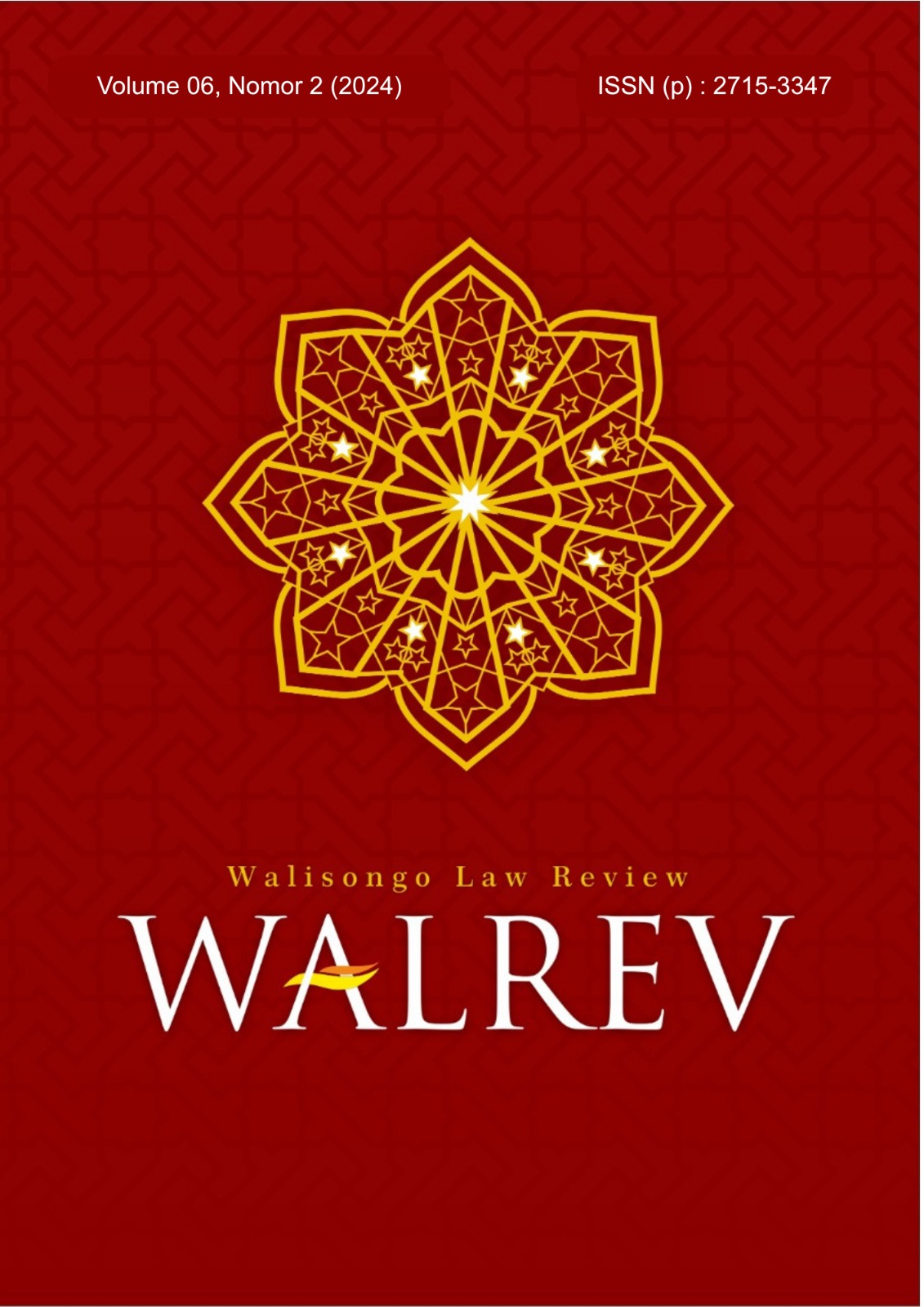Implementation of Artificial Intelligence by Kominfo in the enforcement of pornographic content on social media Twitter (X)
DOI:
https://doi.org/10.21580/walrev.2024.6.2.25737Abstract
This research is motivated by the increasing prevalence of pornographic content, which has significant psychological, social, and economic impacts on Indonesian society. The study examines the application of Artificial Intelligence (AI) by the Ministry of Communication and Informatics (Kementerian Komunikasi dan Informatika, Kominfo) in enforcing laws against pornographic content on Twitter (now known as X). Employing a descriptive qualitative method with a case study approach, the research involved in-depth interviews with 15 key informants. The findings reveal that Kominfo’s AI system utilizes a layered detection model integrating computer vision and natural language processing, achieving an accuracy rate of approximately 85% for visual content and 75% for textual content. The system automates around 80–85% of the detection process through deep packet crawling and inspection techniques. Despite these advancements, law enforcement efforts face several challenges, including a high rate of false positives, difficulties in cross-platform coordination, and limited contextual understanding of local cultural nuances. The study concludes that effective enforcement requires developing more adaptive algorithms supported by comprehensive, Indonesia-specific datasets; enhancing coordination with global social media platforms; establishing an integrated task force; and creating a transparency and accountability framework to ensure a safer digital ecosystem.
Penelitian ini dilatarbelakangi oleh meningkatnya prevalensi konten pornografi yang berdampak signifikan terhadap aspek psikologis, sosial, dan ekonomi masyarakat Indonesia. Studi ini menelaah penerapan Kecerdasan Buatan (Artificial Intelligence, AI) oleh Kementerian Komunikasi dan Informatika (Kominfo) dalam penegakan hukum terhadap konten pornografi di platform media sosial Twitter (kini dikenal sebagai X). Dengan menggunakan metode kualitatif deskriptif melalui pendekatan studi kasus, penelitian ini melibatkan wawancara mendalam dengan 15 informan kunci. Hasil penelitian menunjukkan bahwa sistem AI Kominfo menerapkan model deteksi berlapis yang mengintegrasikan computer vision dan natural language processing, dengan tingkat akurasi sekitar 85% untuk konten visual dan 75% untuk konten tekstual. Sistem ini mampu mengotomatisasi sekitar 80–85% proses deteksi melalui teknik deep packet crawling dan inspection. Meskipun demikian, pelaksanaan penegakan hukum masih menghadapi sejumlah tantangan, antara lain tingginya tingkat false positives, kesulitan koordinasi lintas platform, serta keterbatasan pemahaman terhadap konteks budaya lokal. Penelitian ini menyimpulkan bahwa efektivitas penegakan hukum memerlukan pengembangan algoritma yang lebih adaptif dengan dukungan data set komprehensif yang sesuai dengan konteks Indonesia, peningkatan koordinasi dengan platform media sosial global, pembentukan satuan tugas terpadu, serta pengembangan kerangka transparansi dan akuntabilitas guna menciptakan ekosistem digital yang aman dan berintegritas.
Keywords: Artificial Intelligence; Pornographic Content; Law Enforcement; Twitter (X)
Downloads
References
Aslam, Rifki Chamami. 2024. Respon Negara dalam Menangkal Konten Pornografi di Media Sosial: Peluang dan Tantangan Penegakan Hukum Terhadap Konten Pornografi. Staatsrecht: Jurnal Hukum Kenegaraan dan Politik Islam, 4(1), 29-50. https://doi.org/10.14421/3xpde145
Bahran, Khaerul. 2025. Analisis Yuridis Tentang Pengaturan Pertanggungjawaban Hukum Atas Konten Berbahaya Dalam Media Sosial. Jurnal Riset Multidisiplin Edukasi, 2(5), 450-456. https://doi.org/10.71282/jurmie.v2i5.348.
BR, Wahyudi. 2025. Tantangan Penegakan Hukum terhadap Kejahatan Berbasis Teknologi AI. Innovative: Journal Of Social Science Research, 5(1), 3436–3450. https://doi.org/10.31004/innovative.v5i1.17519
Chasanah, Anissaa Nuril and Arifin, Ridwan. 2022. “The Victimological Context on Child Sexual Violence.” Walisongo Law Review (Walrev), 4(1):19–48. https://doi.org/10.21580/walrev.2022.4.1.10574
Drajat, Amroeni. 2024. Hukum dan Etika dalam Penggunaan Kecerdasan Buatan. WriteBox, 1(4).
Fudong Nian, Teng Li, Yan Wang, Mingliang Xu, Jun Wu. 2016. Pornographic image detection utilizing deep convolutional neural networks, Neurocomputing, 210, 283-293, https://doi.org/10.1016/j.neucom.2015.09.135.
Ministry of Communication and Information. 2023. Kompilasi Regulasi Moderasi Konten Digital.
Indonesian Republic Police. 2023. Laporan Tahunan Direktorat Cyber Crime Polri 2023. Jakarta.
Indonesian Republic Police. 2023. Statistik Kejahatan Siber Terkait Pornografi Tahun 2023. Jakarta.
Ministry of Communication and Information. 2023. Laporan Tahunan Penanganan Konten Negatif 2023. Jakarta.
Ministry of Women's Empowerment and Child Protection. 2023. Laporan Analisis Kekerasan Seksual dan Korelasinya dengan Konsumsi Pornografi. Jakarta.
Ministry of Communication and Information. 2023. Laporan Tahunan Kominfo 2023: Inovasi Teknologi dalam Pengawasan Konten Digital. Jakarta.
Memorandum of Understanding Ministry of Communication and Information and Indonesian Republic Police No. 15/2022 on Handling Cyber Crime.
Indonesian Child Protection Agency. 2023. Laporan Tahunan Kasus Eksploitasi Seksual Anak Online 2023. Jakarta.
Ria Amanda Putri, and Aqeela Adhyanie Hernowo. 2024. Pengaruh Konten Pornografi Terhadap Kesehatan Otak dan Mental dalam Perspektif Islam. IHSANIKA : Jurnal Pendidikan Agama Islam, 2(4), 90–100. https://doi.org/10.59841/ihsanika.v2i4.1887
Regulation of the Minister of Communication and Information Technology No. 5 of 2020 concerning Private Electronic System Providers. Jakarta.
Simanjuntak, W., Subagyo, A., & Sufianto, D. (2024). Peran Pemerintah Dalam Implementasi Artificial Intelligence (AI) Di Kementerian Komunikasi Dan Informatika Republik Indonesia (Kemenkominfo RI). Journal of Social and Economics Research, 6(1), 1-15. https://doi.org/10.54783/jser.v6i1.332
Law Number 44 of 2008 concerning Pornography.
Law Number 35 of 2014 concerning Child Protection.
Law Number 19 of 2016 concerning Amendments to Law Number 11 of 2008 concerning Electronic Information and Transactions.
Presidential Regulation Number 44 of 2019 concerning the National Task Force for the Prevention and Handling of Negative Content on the Internet.
Presidential Regulation Number 28 of 2021 concerning the National Cyber and Crypto Agency.
Pabila Syaftahan. 2024. Kelemahan Kecerdasan Buatan: Tantangan dan Risiko di Era AI. https://aihub.id/pengetahuan-dasar/tantangan-dan-risiko-ai
Wahid, Abdul, and Mohammad Labib. 2005. Kejahatan Mayantara (Cyber Crime. Jakarta: PT. Refika Aditama.
Wendratama, Engelbertus. 2023. Pengaturan Konten Ilegal dan Berbahaya di Media Sosial: Riset Pengalaman Pengguna dan Rekomendasi Kebijakan. Yogyakarta: PR2Media.
Downloads
Published
How to Cite
Issue
Section
License
Copyright (c) 2024 Fahririn, Cakra Heru Santosa, M. Ihsan Maulana

This work is licensed under a Creative Commons Attribution-ShareAlike 4.0 International License.










